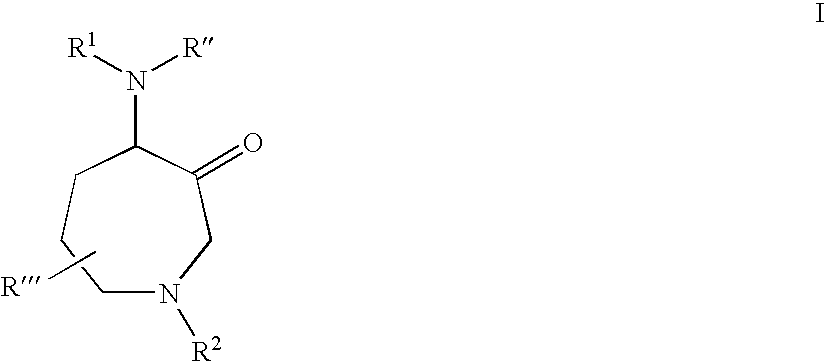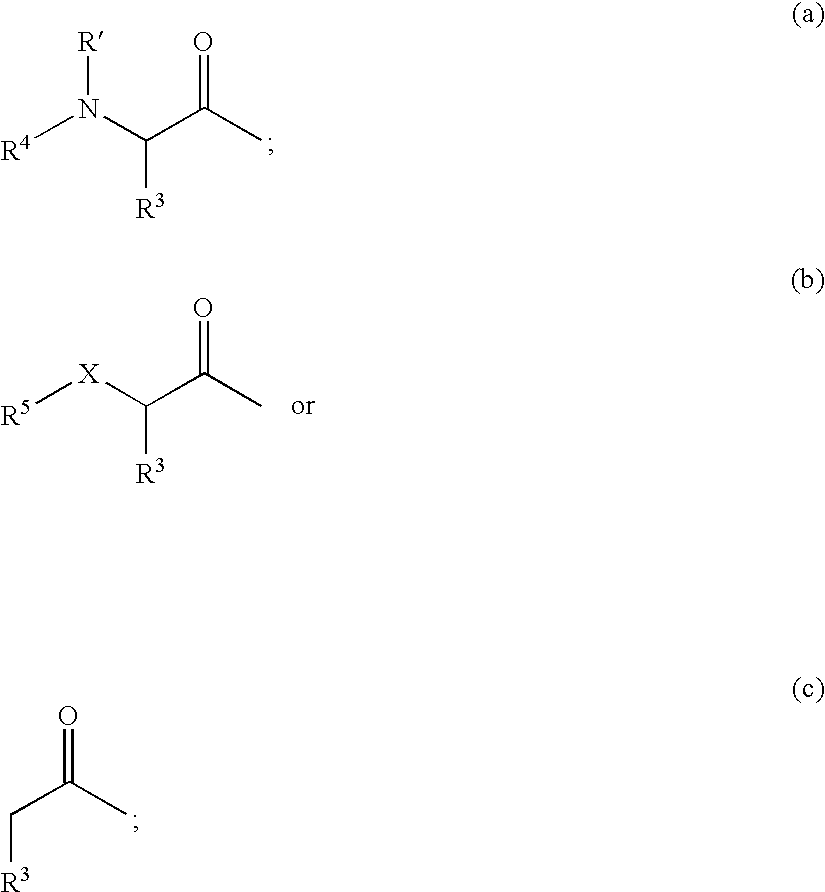Protease inhibitors
a protease inhibitor and protease technology, applied in the field of protease inhibitors, to achieve the effect of treating or preventing autoimmune diseases
- Summary
- Abstract
- Description
- Claims
- Application Information
AI Technical Summary
Problems solved by technology
Method used
Image
Examples
example 1
Preparation of 1A: Morpholine 4-carboxylic acid {(S)-2-[1-methylcyclopentyl-1-(4S,7R)-7-methyl-3-oxo-1-(1-oxy-pyridine-2-sulfonyl)-azepan-4-ylcarbamoyl]-ethyl}-amide
[0145]
Preparation of 1B: Morpholine 4-carboxylic acid {(L)-2-[1-methylcyclopentyl-1-(4S,7R)-7-methyl-3-oxo-1-(1-oxy-pyridine-2-sulfonyl)-azepan-4-ylcarbamoyl]-ethyl}-amide
[0146]
1a.) 1-Methyl methylcyclopentanecarboxylate
[0147] Butyllithium (1.6 M, 48.75 mL, 78 mmol) was added dropwise to a stirred solution of diisopropylamine (7.88 g, 44.5 mmol) in tetrahydrofuran (12 mL) at −78° C. The solution was warmed to room temperature to ensure the evaporation of butane and then cooled to −78° C. again. Methylcyclopentanecarboxylate (10.0 g, 78 mmol) in tetrahydrofuran (100 mL) was added to the reaction mixture at −78° C. After addition, the reaction mixture was warmed to 0° C. temperature for 30 mins. After cooling to −78° C., iodomethane (11.1 g, 78 mmol) in tetrahydrofuran (30 mL) was added. After addition, the reaction mix...
example 2
Preparation of 2A: Morpholine 4-carboxylic acid {(S)-2-[1-methylcyclohexyl-1-(4S,7R)-7-methyl-3-oxo-1-(1-oxy-pyridine-2-sulfonyl)-azepan-4-ylcarbamoyl]-ethyl}-amide
[0169]
Preparation of 2B: Morpholine 4-carboxylic acid {(L)-2-[1-methylcyclohexyl-1-(4S,7R)-7-methyl-3-oxo-1-(1-oxy-pyridine-2-sulfonyl)-azepan-4-ylcarbamoyl]-ethyl}-amide
[0170]
[0171] Following the procedure of Example 1(b-r), except substituting “1-methylcyclohexyl” for “1-methylcyclopentyl” gave the title compound: 1HNMR data of 2A: 1H NMR (400 Hz, CDCl3): δ 8.72 (d, 1H), 7.95 (m, 2H), 7.5 (d, 1H), 6.91 (d, 1H), 5.10 (m, 1H), 4.95 (d, 1h), 4.75 (d, 1H), 4.40 (m, 2H), 3.82 (d, 1H), 3.70 (t, 4h), 3.40 (t, 4H), 2.20 (m, 3H), 0.95-1.80 (m, 19H). The 1H NMR data of 2B: 1H NMR (400 Hz, CDCl3): δ 8.70 (d, 1H), 7.95 (m, 2H), 7.52 (m, 1H), 7.2 (d, 1H), 5.10 (m, 1H), 4.83 (d, 1H), 4.70 (d, 1H), 4.44 (m, 2H), 3.82 (d, 1H), 3.70 (t, 4H), 3.40 (t, 4H), 2.2 (m, 2H), 1.9 (m, 1H), 0.95-1.5 (m, 8H).
example 3
Preparation of 3A: Furan-carboxylic acid {(S)-2-[1-methylcyclohexyl-1-(4S,7R)-7-methyl-3-oxo-1-(1-oxy-pyridine-2-sulfonyl)-azepan-4-ylcarbamoyl]-ethyl}-amide
[0172]
Preparation 3B: Furan-carboxylic acid {(L)-2-[1-methylcyclohexyl-1-(4S,7R)-7-methyl-3-oxo-1-(1-oxy-pyridine-2-sulfonyl)-azepan-4-ylcarbamoyl]-ethyl}-amide
[0173]
3a) Furan-2-carboxylic acid [1-[(3S,4S,7R)-3-hydroxy-7-methyl-1-(pyridine-2 sulfonyl)-azepan-4-ylcarbamoyl]-2-(1-methyl-cyclopentyl)-ethyl]-amide
[0174] To a solution of 2-amino-N-[(3S,4S,7R)-3-hydroxy-7-methyl-1-(pyridine-2-sulfonyl)-azepan-4-yl]-3-(1-methyl-cyclohexyl)-propionamide, HCl salt (Example 2o, 357 mg, 0.73 mmol) in DMF, 2-furoic acid (81.8 mg, 0.73 mmol), HBTU (360 mg, 0.95 mmol) and 4-methylmorpholine (369 mg, 3.65 mmol) were added. After the reaction mixture was stirred at room temperature for 16 hours, it was partitioned between ethyl acetate and water. The combined organic phase was washed with water, brine, dried (MgSO4), filtered and concentrate...
PUM
| Property | Measurement | Unit |
|---|---|---|
| temperature | aaaaa | aaaaa |
| temperature | aaaaa | aaaaa |
| reflux temperature | aaaaa | aaaaa |
Abstract
Description
Claims
Application Information
 Login to View More
Login to View More - R&D
- Intellectual Property
- Life Sciences
- Materials
- Tech Scout
- Unparalleled Data Quality
- Higher Quality Content
- 60% Fewer Hallucinations
Browse by: Latest US Patents, China's latest patents, Technical Efficacy Thesaurus, Application Domain, Technology Topic, Popular Technical Reports.
© 2025 PatSnap. All rights reserved.Legal|Privacy policy|Modern Slavery Act Transparency Statement|Sitemap|About US| Contact US: help@patsnap.com



